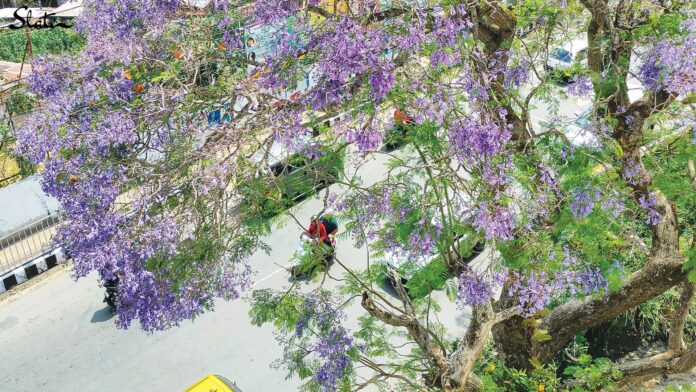By Nishanth Srinivas
Every summer, just before the monsoon takes a firm grip over Shillong, the different neighbourhoods of the city become punctuated by purple-blue canopies of the blue jacaranda. The blue hues of the jacaranda are very much analogous to the pink hues of the cherry trees, the latter of which is more abundant and widely celebrated than the lesser known yet widely planted Jacaranda.
Etymology
The scientific name of the blue Jacaranda is Jacaranda mimosifolia. The name Jacaranda as it is commonly known, comes from the South American Tupi- Guaraní language, which means fragrant or sweet-smelling. It probably alludes to the very mild pleasant fragrance akin to sweet grape soda.
Mimosifolia alludes to the Mimosa tree-like dark green leaves that look similar to fern leaves, being bi-pinnately compound.
There are up to 50 different species under the genus of Jacaranda, but when people speak about Jacaranda, they mostly refer to Jacaranda mimosifolia, which is the most popular and widely planted world over.
The local names in South Asia for this non-native tree mostly refer to its purple-blue flowers which bloom in spring.
In Hindi, the tree is known as Neel Mohar or Neeli Gulmohar; Neelkanth in Bengali; and Bhangeree Phool in Nepali.
Natural history of Jacaranda
Blue Jacaranda is a deciduous, fast-growing tree attaining heights of up to 20m. The tree is endemic to a bioregion known as the Yungas, which are a narrow band of piedmont (French for foothill) forests, growing along the eastern slopes of Peru, Bolivia, and north-west Argentina up to 2600 meters elevation.
The tree belongs to the Bignoniaceae family or Trumpet vine family.
This pantropical family mostly consists of lianas, trees, and shrubs comprising some very well-known ornamental genera like Tabebuia, Tecoma, Spathodea campanulate (African tulip tree), and Pyrostegia venusta (orange trumpet vine) – all of which, like the Jacaranda, are planted for their colourful blooms.
The hallmark of the family is that their flowers are sympetalous, having the petals united along their margins to form a tubular shape.
Blue Jacaranda tubular flowers are arranged in a branched form called panicle.
Fruits of Bignoniaceae are usually bivalved capsules with seeds being flat and winged as in the case of Jacaranda. The seeds are dispersed by the wind.
This tropical tree species, though adaptable to many soil types, prefers slightly acidic soils.
The subtropical climate and the slightly acidic soil pH make Shillong an ideal place for Jacarandas.
The tree is dormant during winter, losing its leaves during late winter or early spring. A visual synchrony of flowering violet canopies of these otherwise inconspicuous trees dotting the city symbolises a change of season.
The end of April and early May is the peak flowering time here in Shillong.
People, Jacarandas and Phenology
From Pretoria in South Africa to New South Wales in Australia; from Shillong, Meghalaya to Munnar in Kerala, Jacarandas have been planted in many cities and towns far and wide.
The presence of this tree in many former British colonies is thought to be attributed to Allan Cunningham, a 19th century English botanist and explorer, who is said to have become enchanted by its beauty during his travels in Brazil in 1818.
Despite the colonial origins of this alien tree, it is claimed as being a part of the urbanscapes that it has been planted in. Pretoria, for instance, is known as ‘Jacaranda City’ as there are over 30,000 trees. So enamoured were the city planners by the pulchritude of its canopy, they planted it en masse.
Despite being introduced in Pretoria and Johannesburg, South Africa, only in the early 1800s Jacaranda trees populated the tree planting drives and the psyche of the people of other African cities and towns, that it even finds a place in Nelson Mandela’s inaugural speech as the first president of South Africa.
For the countries in the southern hemisphere like Australia and South Africa, the Jacarandas bloom during October and November, and it is marked as the herald of the spring season. This also coincides with year-end university exams in these places, which has earned the Jacaranda the moniker “ Exam tree”.
There is even a popular aphorism among students at the University of Queensland, which goes, “If you haven’t started studying by the time jacarandas started to bloom, you will fail your exams!”.
Phenology is the study of the timing of recurring biological events in plants and animals regarding biotic and abiotic forces, which dictate them. The timing of the flowering of trees is a good example to understand the effects of climate change. Observing the phenological response like the timing of flowering will give insight into the threats a warming climate poses for biological events.
A study from the Guanteng province of South Africa, which compiled the list of flowering dates of jacarandas in the city spanning 92 years, report that the trees that started to bloom in mid-November in 1920-30s, have over the decades gradually advanced to the early weeks of September. This change in flowering season is referred to as a phenological shift and is being observed across a range of species globally because of climate change.
Phenological shifts through adaptations to changes in climatic and environmental factors can’t happen endlessly in the face of anthropogenic climate change. Beyond a critical threshold, the flowering season will become unsuccessful. The brilliant flowering urban jacarandas can be easily observed and monitored by anyone, and can serve as ideal study species to understand phenological shifts.
Despite being a non-native tree, with no impact on local ecology or utility beyond aesthetics, the jacaranda is part of the urban green in Shillong and elsewhere where it has been planted, continuing to enthral the locale with a hurricane of purple-blue every spring!


